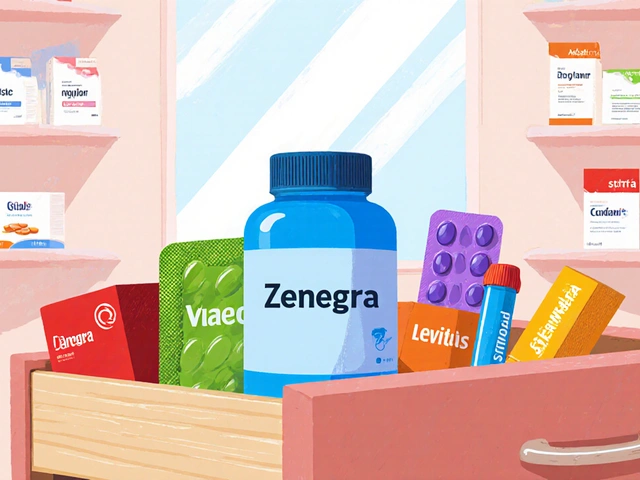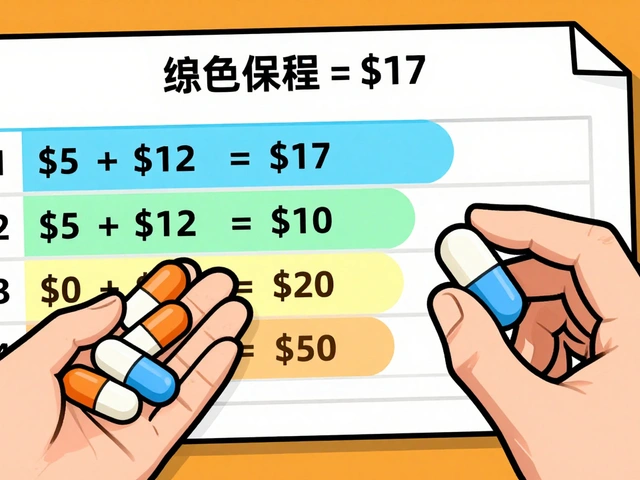
Angina is a clinical syndrome of chest discomfort caused by reduced blood flow to the heart muscle (myocardial ischemia), typically triggered by physical exertion or emotional stress. It affects roughly 2% of the UK adult population and is a hallmark sign of underlying coronary artery disease. When the pain strikes, it does more than signal a cardiovascular problem - it often sparks a cascade of emotional reactions.
What is Angina?
Angina presents as pressure, squeezing, burning or tightness in the chest, sometimes radiating to the left arm, jaw or back. It can be classified into three main types:
- Stable angina - predictable, occurs with exertion, relieves with rest or medication.
- Unstable angina - unpredictable, may happen at rest, signals heightened risk of heart attack.
- Microvascular (or “angina equivalents”) - chest pain despite normal large‑artery scans, often linked to endothelial dysfunction.
Regardless of type, the sensation of chest pain is a potent alarm system that the brain interprets as danger.
How Chest Pain Triggers Emotional Responses
The moment you feel a tightening chest, the autonomic nervous system kicks into high gear. Heart rate spikes, adrenaline floods the bloodstream, and cortisol levels rise - a classic "fight‑or‑flight" reaction. These physiological changes are exactly the same ones that fuel anxiety and panic attacks.
Studies from the British Heart Foundation (2022) show that up to 30% of people with stable angina report moderate to severe anxiety within the first six months of diagnosis. The brain’s threat‑detection circuits (the amygdala and insular cortex) become sensitised, making future episodes feel more frightening even when the physical trigger is mild.
Bidirectional Link: Mental Health Influencing Angina
It’s not a one‑way street. Chronic stress, depression and anxiety can worsen myocardial oxygen demand, raise blood pressure, and promote plaque instability. A 2023 NICE guideline cites a 1.5‑fold increase in angina episodes among patients with high perceived stress scores.
In practical terms, a person who is constantly worrying about heart health may experience chest tightness during a routine walk, interpreting it as an impending heart attack. This misinterpretation amplifies the pain, creating a self‑fulfilling loop.
Common Psychological Conditions Linked to Angina
Beyond generic anxiety, several specific mental‑health issues intersect with angina:
- Generalised Anxiety Disorder (GAD) - persistent worry about health, often manifesting as "health anxiety".
- Depression - low mood and fatigue can mask angina symptoms, leading to delayed treatment.
- Panic Disorder - sudden panic attacks can mimic unstable angina, prompting unnecessary emergency visits.
- Health‑Related Quality of Life (HRQoL) impairment - measured by tools such as the Seattle Angina Questionnaire, which routinely shows lower scores in patients with comorbid depression.
Data from the UK’s Clinical Practice Research Datalink (CPRD, 2021) indicate that 25% of angina patients had a recorded diagnosis of depression within two years of their cardiac event.

Managing the Emotional Impact - Practical Strategies
Addressing the mental side of angina starts with acknowledging the link. Here are evidence‑based actions:
- Education and reassurance - Clear explanations from a cardiologist reduce fear. Knowing the difference between stable and unstable pain cuts down unnecessary emergency calls.
- Cardiac rehabilitation - A multidisciplinary programme that combines supervised exercise, nutrition advice and stress‑management training. A meta‑analysis (European Journal of Preventive Cardiology, 2022) found a 35% reduction in anxiety scores after 12 weeks of rehab.
- Psychological therapies - Cognitive‑behavioural therapy (CBT) designed for cardiac patients helps reframe catastrophic thoughts. Randomised trials in the UK show CBT reduces depressive symptoms by 0.8SD.
- Medication review - Some beta‑blockers (e.g., atenolol) have mild anxiolytic properties, whereas high‑dose nitrates may provoke anxiety in sensitive individuals.
- Lifestyle modification - Regular aerobic activity, Mediterranean‑style diet, and adequate sleep lower both angina frequency and stress hormones.
- Mindfulness and relaxation - Practices such as progressive muscle relaxation or guided imagery have been shown to cut perceived chest discomfort by up to 20% in a 2020 NHS pilot.
Comparing Types of Angina
| Attribute | Stable Angina | Unstable Angina | Microvascular Angina |
|---|---|---|---|
| Trigger | Physical exertion or emotional stress | At rest, minimal exertion | Often no clear trigger |
| Duration | 5‑15 minutes, relieved by rest/GTN | Variable, may persist >20 minutes | Often longer, < 5 minutes relief |
| Risk of Heart Attack | Low to moderate | High (immediate medical attention) | Intermediate, linked to endothelial dysfunction |
| Typical Treatment | Beta‑blocker, nitrates, lifestyle | Dual antiplatelet therapy, possible revascularisation | Calcium‑channel blockers, ranolazine, rehab |
Understanding the type you have informs both medical and emotional coping strategies. Unstable angina, for example, warrants urgent evaluation, which can alleviate the anxiety of “waiting for the next episode”.
When to Seek Help - Red Flags
Chest pain that is new, worsening, or accompanied by any of the following should trigger an immediate call to emergency services:
- Sudden, crushing pain radiating to the left arm or jaw.
- Shortness of breath, sweating, nausea, or faintness.
- Pain lasting longer than 20 minutes despite rest.
- New onset of anxiety or panic that feels out of proportion to the physical trigger.
Early medical assessment not only protects the heart but also reduces the psychological burden of uncertainty.
Next Steps and Resources
If you or someone you know lives with angina, consider the following actionable checklist:
- Schedule a cardiology review to confirm the exact angina classification.
- Ask about enrolment in a cardiac rehabilitation programme that includes a psychologist.
- Request a medication audit - ensure beta‑blockers or other agents are optimised for both heart and mood.
- Begin a low‑intensity walking routine (10‑15 minutes, 5 days a week) and track symptoms with a simple diary.
- Explore mindfulness apps endorsed by the NHS, such as “Headspace for Heart Health”.
- Keep an emergency plan: note your GP’s contact, a list of current meds, and when to call 999.
Supporting your heart and mind together leads to a better quality of life, fewer hospital visits, and a stronger sense of control.

Frequently Asked Questions
Can anxiety cause chest pain that mimics angina?
Yes. Anxiety can trigger the same autonomic response that produces chest tightness, often called “non‑cardiac chest pain”. The key difference is that cardiac tests (ECG, stress test) are normal. However, persistent anxiety still warrants evaluation because it can aggravate existing angina.
Is it safe to take antidepressants if I have angina?
Most antidepressants, especially SSRIs, are considered safe for people with coronary artery disease. They do not increase heart‑attack risk and can actually improve adherence to cardiac medication by lifting mood. Always discuss dosage with your cardiologist and GP.
How quickly can cardiac rehabilitation improve my mental health?
Research shows measurable reductions in anxiety and depressive symptoms after just 6‑8 weeks of a structured rehab programme, with the biggest gains occurring in the first three months.
Should I avoid strenuous exercise because it might trigger angina?
Controlled, moderate‑intensity exercise actually raises the pain threshold and improves blood flow. A supervised exercise test determines your safe range, after which you can safely increase activity without heightening anxiety.
What are the signs that my chest pain is an emergency?
Sudden, crushing pain, pain that spreads to the arm, jaw or back, shortness of breath, sweating, nausea, or loss of consciousness are red‑flag symptoms. Call 999 immediately if any appear.
10 Comments
Travis Evans
September 26 2025
Hey folks, just wanted to shout out how crucial it is to blend the cardio rehab with some real‑life stress‑busting hacks. Think of your heart like a high‑performance engine – you wouldn’t ignore the oil change, right? So toss in a daily walk, a splash of Mediterranean diet, and maybe a quick 5‑minute breathing drill before that big meeting. Trust me, those colorful mind‑tricks can mute the anxiety spikes that usually ride on angina episodes. Keep the momentum, and your ticker will thank you.
Jessica Hakizimana
September 27 2025
Living with angina can feel like walking a tightrope over a canyon of worries, but there’s a bright side that often hides behind the clouds of discomfort.
Your heart’s signals are not just warnings; they’re also invitations to tune into your body’s language.
When you recognize that a racing pulse is part of the fight‑or‑flight chorus, you can gently redirect that energy into soothing breaths.
Mindfulness doesn’t have to be a lofty, zen‑like practice reserved for monks – a few moments of focused attention can shift the narrative.
Imagine swapping the mental script of “I’m about to die” for “I’m feeling tight, I’ll pause and breathe.”
Research shows that such cognitive reframing, especially when paired with cardiac rehab, slashes anxiety scores by a solid third.
Moreover, regular aerobic activity builds a stronger myocardial reserve, which means your heart can handle stressors with less strain.
That, in turn, reduces the frequency of those pesky chest tightness episodes that trigger the fear loop.
Don’t underestimate the power of a supportive community either; sharing your story in a rehab group can dissolve the isolation that fuels depression.
A simple weekly check‑in with a therapist can uncover hidden catastrophizing thoughts before they snowball.
Even the foods you choose play a starring role – omega‑3 rich fish, leafy greens, and nuts act like friendly firefighters dousing the flames of inflammation.
If you’re on beta‑blockers, ask your doctor about their mild anxiolytic side‑effects, which can be a pleasant bonus.
And remember, medication isn’t a one‑size‑fits‑all; a personalized audit can balance heart health and mood stability.
Celebrate each small victory, whether it’s a 5‑minute walk without pain or a night of uninterrupted sleep.
These milestones build confidence, and confidence is the antidote to the spiral of health‑related anxiety.
So keep the dialogue open with your care team, stay curious, and let both heart and mind thrive together.
peter derks
September 29 2025
Great rundown! I’d add that setting realistic micro‑goals, like adding a 2‑minute stretch after each rehab session, can keep motivation high and prevent the overwhelm you mentioned.
Sarah DeMaranville
September 30 2025
While the article paints a rosy picture, not every angina patient benefits from mindfulness or cardio rehab the same way.
Edward Leger
October 1 2025
It’s true that individual responses vary; however, the underlying physiological link between stress and myocardial oxygen demand remains a constant factor worth addressing.
Keyla Garcia
October 3 2025
OMG the anxiety from chest pain is like a roller‑coaster 🎢🔥
Maureen Hoffmann
October 4 2025
Hang in there! A dash of humor and a solid rehab plan can transform that roller‑coaster into a breezy ride – plus, proper grammar helps keep the mind sharp while you’re at it 😉
Stephen Richter
October 5 2025
In accordance with current NICE guidelines the integration of psychological assessment into routine cardiac care is advisable for optimal patient outcomes.
leo calzoni
October 7 2025
That's simplistic; the real issue is that clinicians often ignore the psychosocial dimension until it becomes a crisis.




Patrick Price
September 25 2025
Yo i u know this chest pain thing feels like your heart's throwin a tantrum lol